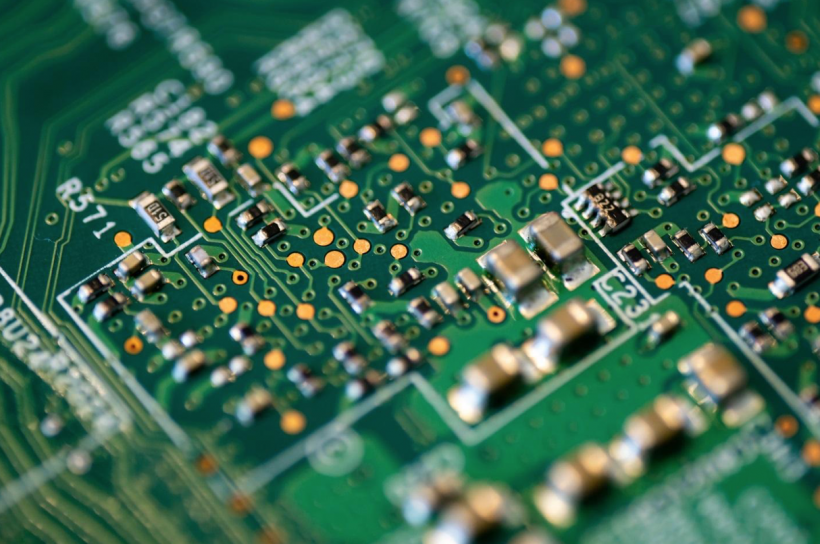The list of basic electronic components available for building electronic circuits is quite big. Basic components are useful in completing circuit designs and enabling proper functioning. Examples of these components used to develop electronic parts include capacitors, resistors, diodes, integrated circuits, and more. Components come in different forms. Some, like integrated circuits, have different semiconductor devices integrated, while others have more than one terminal soldered into a circuit board.
Basic electronic components are divided into two categories: Active components and passive components. We will look at each of these categories of basic electronic components below.
Passive components
Passive components are those which can store energy as current or voltage. They include capacitors, resistors, motors, memristors, and inductors.
Capacitors
Capacitors store electricity in the form of an electric field. They consist of two conductive plates separated by an insulator. Capacitors allow AC signals and block DC signals. Capacitors are used with resistors in timing circuits. There are different types of capacitors including electrolytic, variable, ceramic, and film capacitors. Additional uses of capacitors include signal coupling and decoupling, power conditioning, remote sensing, and electronic noise filtering.
Fixed and variable resistors
A resistor has many functions including; limiting current flow, dividing voltages, terminating transmission lines, adjusting signal level, and biasing active elements. It has two terminals and works based on the principle that the voltage applied across a resistor’s terminal is directly proportional to the current flow. There are different types of resistors based on material, power rating, and resistance value.
Fixed resistors set the ideal conditions in a circuit. Resistance values in a fixed resistor are set at the time of designing the circuit. You, therefore, do not need to adjust the circuit when using a fixed resistor. Variable resistors, on the other hand, comprise an element of a fixed resistor and a slide which allows variations. They are useful in changing the resistance in an electronic circuit as per the requirements.
Inductors or AC resistors
AC resistors store electricity in a magnetic form and produce magnetic lines, a capability known as inductance. They resist changes in current. Inductors also separate signals of different frequencies in electronic filters. They are also used in tuning circuits, induction motors, chokes, transformers, sensors, ferrite beads, and more.
Active components
Active components depend on an energy source and can control the electrons which flow through them. They include diodes, integrated circuits, LCD; LED; and CRT displays, transistors, PV cells, batteries, and other sources of AC and DC supply.
Transistors
A transistor is a semiconductor with three terminals, used as a switch and an amplifier for electrical power and signals. Either a current or voltage controls the switch. When you control the voltage passing through one terminal, it also affects the remaining two terminals.
Diodes
A diode is also a semiconductor material device that allows current flow in a single direction. It is made up of the cathode and snide terminals and is used to convert AC to DC circuits. Some types of diodes include LEDs, Zener, and Photodiodes. Diodes are also used as voltage regulators, signal modulators, mixers, and demodulators, oscillators, and switches.
Integrated circuits
An integrated circuit contains thousands of transistors, diodes, resistors, and other electronic components on a small silicon chip. ICs form the building blocks of electronic devices such as computers and phones. They can be either analog or digital, and linear or non-linear.
Batteries
Batteries convert chemical to electrical energy through electrolyte reactions. They are the most common power source for most devices. Battery cells can either be primary or secondary. Primary cells are not rechargeable while secondary cells are.
Display devices
Liquid Crystal Displays are a kind of display technology used in computers, phones, and calculator screens. An LCD makes use of two polarized filters and electrodes to disable or enable light to reflective backing on the screen where the viewer can see displayed text or image.
TVs and computers use Cathode Ray Tubes (CRTs). CRT is a long vacuum tube with a flattened surface that has components such as an electron gun, a phosphorescent screen, and an electron beam.
Hopefully, you are now familiar with a few of the basic electronic components that comprise the most common electronic equipment.
Laila Azzahra is a professional writer and blogger that loves to write about technology, business, entertainment, science, and health.
